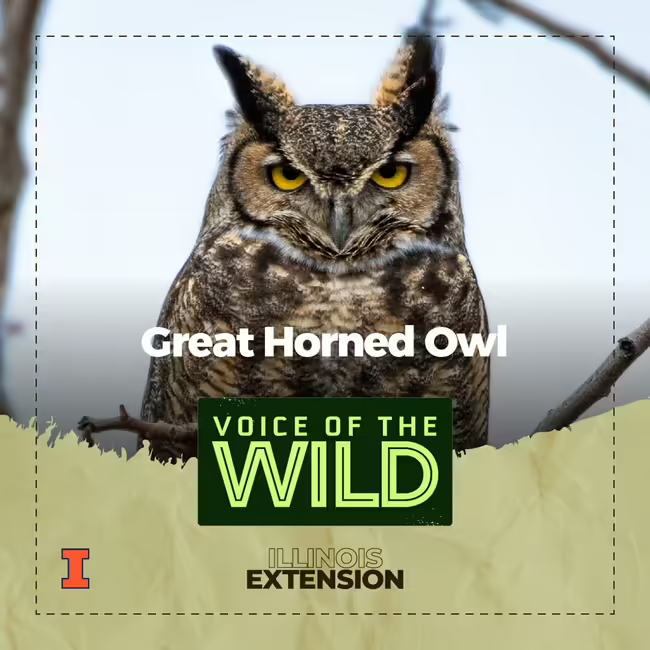
Episode Number
38
Episode Show Notes / Description
Great horned owl (Bubo virginianus).
The quintessential “whooo” owl call belongs to the Great horned owl, North America’s most widespread owl species. The haunting duet of a pair of Great Horned Owls can be heard in the late night and early morning hours of mid to late winter.
The quintessential “whooo” owl call belongs to the Great horned owl, North America’s most widespread owl species. The haunting duet of a pair of Great Horned Owls can be heard in the late night and early morning hours of mid to late winter.
Do you want to learn more bird songs, frog calls, and insect noises? Join Voice of the Wild every Friday to explore a new wild voice. We’re available on most podcast platforms, including Apple Podcasts, Spotify, and YouTube.
Subscription links Here
Subscribe to the Newsletter
Listen online on our Homepage
The following Cornell Lab | Macaulay Library recordings were used in this episode:
- Great horned owl duet songs by William R. Fish (ML506981)
- Great horned owl screech with song by Wil Hershberger (ML506982)
- Great horned owl bill snapping by William W. H. Gunn (ML506989)
- Great horned owl "haunting" song by Gerrit Vyn (ML506983)
Sources and more:
- https://www.allaboutbirds.org/guide/Great_Horned_Owl
- https://www.audubon.org/field-guide/bird/great-horned-owl
Transcript
This is Illinois Extension’s Voice of the Wild. A new wild voice in just a moment, so find someplace quiet, take a deep breath, and enjoy.
The quintessential “who” and an extraordinary predator with a year-round range spans nearly all of North America. Despite the two tufts of feathers coming out the top of its head, this owl is marvelously camouflaged and tends to stay high in coniferous trees. This makes finding one rather difficult. During the day you can look beneath tall pine and spruce trees for pellets and whitewash, both evidence that an owl of some kind is roosting above, but you’re more likely to find this owl with the help of crows. They are predated heavily by large owls and don’t take kindly to one roosting in their territory, so if you are on a hike through the woods and hear a group of crows making a ruckus, follow your ears and you may discover they're mobbing this fearsome owl.
This is the Great Horned Owl (Bubo virginianus) from the owl family, Strigidae
Early in a midwinter morning, well before the sun has risen, is a great time to listen for the haunting hoots of the great horned owl. They establish their territory by hooting and a pair will hoot together as part of their courtship for many weeks, tapering off after they’ve established a nest and laid their eggs in the late winter or early spring. Here’s the great horned owl again.
Thank you to the Macaulay library at the Cornell lab for our bird sounds. And thank you for tuning in to learn a new wild voice with Illinois Extension.
The quintessential “who” and an extraordinary predator with a year-round range spans nearly all of North America. Despite the two tufts of feathers coming out the top of its head, this owl is marvelously camouflaged and tends to stay high in coniferous trees. This makes finding one rather difficult. During the day you can look beneath tall pine and spruce trees for pellets and whitewash, both evidence that an owl of some kind is roosting above, but you’re more likely to find this owl with the help of crows. They are predated heavily by large owls and don’t take kindly to one roosting in their territory, so if you are on a hike through the woods and hear a group of crows making a ruckus, follow your ears and you may discover they're mobbing this fearsome owl.
This is the Great Horned Owl (Bubo virginianus) from the owl family, Strigidae
Early in a midwinter morning, well before the sun has risen, is a great time to listen for the haunting hoots of the great horned owl. They establish their territory by hooting and a pair will hoot together as part of their courtship for many weeks, tapering off after they’ve established a nest and laid their eggs in the late winter or early spring. Here’s the great horned owl again.
Thank you to the Macaulay library at the Cornell lab for our bird sounds. And thank you for tuning in to learn a new wild voice with Illinois Extension.